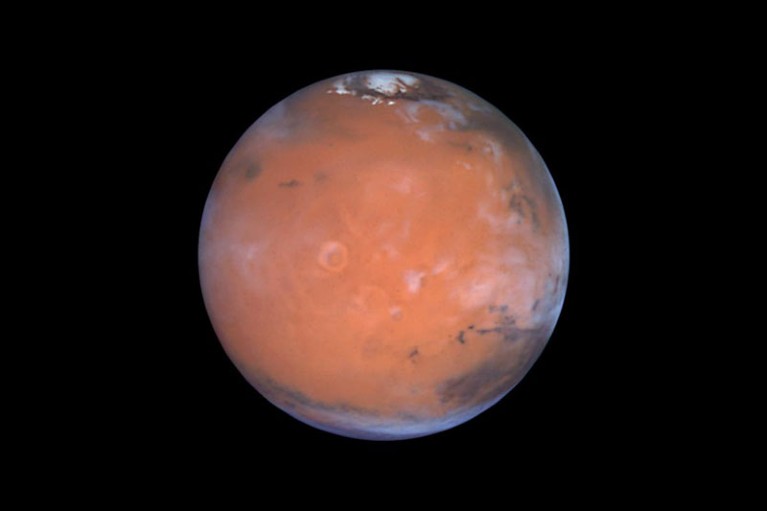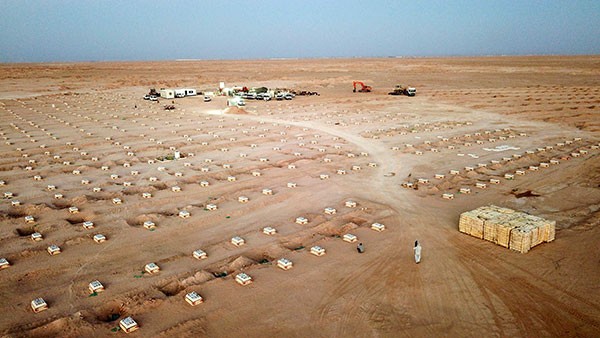Hello Nature readers, would you like to get this Briefing in your inbox free every day? Sign up here

Scientists have long thought that there could be water trapped beneath the surface of Mars.Credit: Steve Lee, Univ. Colorado/Jim Bell, Cornell Univ./Mike Wolff, SSI/NASA
Subsurface lakes discovered on Mars
Planetary scientists have confirmed the presence of a large saltwater lake under the ice at Mars’s south pole — and have found three more. The discovery was made using radar data from the European Space Agency’s Mars-orbiting spacecraft, called Mars Express. It builds on evidence, gathered two years ago, of the first body of liquid water ever detected on the red planet. The largest, central lake measures 30 kilometres across, and is surrounded by 3 smaller lakes, each a few kilometres wide. Life is able to survive in subglacial lakes in places such as Antarctica, but the lakes on Mars might be too salty. Or they might not be liquid water at all; it’s so cold, they could be slush.
Reference: Nature Astronomy paper
World leaders pledge to save life on Earth
The leaders of 71 countries have pledged to reverse biodiversity loss by 2030. The commitment comes ahead of a major UN biodiversity summit on Wednesday, which will be virtually hosted from New York. “We commit ourselves not simply to words, but to meaningful action and mutual accountability to address the planetary emergency,” says the pledge, which is signed by Pakistan’s Imran Khan, Germany’s Angela Merkel, Canada’s Justin Trudeau and the United Kingdom’s Boris Johnson, among others. Leaders from the United States, Brazil, India, Russia and China are notably absent.
Reference: Leaders’ Pledge for Nature
What Supreme Court pick means for science
US president Donald Trump’s nominee for the US Supreme Court is “a bit of a cipher, particularly in the science-related areas of law”, says environmental-law scholar Robin Craig. But legal scholars say that a powerful conservative majority would be likely to further defang environmental regulation, temper the influence of federal science agencies in highly technical court cases and change the transparency required of such agencies. If confirmed, conservative legal scholar, appeals-court judge and law professor Amy Coney Barrett would take the seat vacated by the late Ruth Bader Ginsburg. Ginsburg leaves behind a legacy of rulings that protect the environment and tended to defer to the expertise of government scientists.
Features & opinion
How to digitize your lab notebooks
Converting paper records to digital formats provides secure back-ups that researchers can access from anywhere — which is especially handy with many of us working from home. Scanning can be accomplished with a smartphone (and a lot of time). Or, you can ramp up to a flatbed scanner or even hire a company to do the hard work for you.
The Arctic is burning in a whole new way
The Arctic fire regime is changing, with strong consequences for the global climate, write fire scientists Jessica McCarty, Thomas Smith and Merritt Turetsky. New factors include ‘zombie fires’, which smoulder in carbon-rich peat below the surface for months or years, and the burning of what were thought to be ‘fire-resistant’ ecosystems, such as tundra bogs, fens and marshes. The authors call for a pan-Arctic fire-monitoring system, including the expertise of local and Indigenous communities, to understand the future of fire in the far north.
Nature Geoscience | 6 min read
Chasing chemistry’s holy grails
From room temperature superconductivity to artificial leaves, Chemistry World explores how far chemistry has come since Accounts of Chemical Research named its “holy grails” of chemistry 25 years ago. The aim was to highlight promising pathways in the field as a challenge to curious minds, writes Chemistry World deputy editor Philip Robinson: “a gauntlet as much as a grail”. Maybe the real grail was the discoveries we made along the way, argues science writer Philip Ball.

